
Stage 1: The Pacific Crossing
Eighteen days at sea to clear the
mind for what lies ahead
For the eighteen, or so, months prior to May, 02005 my life consisted of a seemingly endless string of uncertain plans, exhalations and disappointments as I tried to finally commit once and for all to starting the Tout of Gondwana. Those continued almost up until May 04, the very day I walked up the gangplank of the M.V. Direct Kestrel, a 190m-long container ship that was to take me from California to Melbourne, Australia, where I would begin the cycling portion of the tour for Stage 1. Only after I was on board, all the cargo containers had been loaded into the ships holds and onto its decks, and the I watched San Clemente Island, the last land of North America I would be seeing for quite a while, disappear to the stern of the ship, did I finally let myself believe that there was no turning back, and no one could make me go back. Perhaps I was not 100% convinced of that last point, though, and for several days I had the nagging feeling that someone would contact the ship, and say "no, you can't go after all." Fortunately, that did not happen.
The Direct Kestrel did its job splendidly and we arrived at about 5:00 AM on May 22nd. That was pretty close to being just when I expected to arrive, but we were delayed for several hours while the cargo was loaded in L.A., so we did not sail until 5:00 AM on May 5. There was also a day or two in the South Pacific where currents and high seas slowed us down somewhat. However, the rest of the time we were running slightly faster than expected, due to a slightly lighter than normal load of cargo, so our average speed (18.5 knotts, in case you were wondering) was fast enough to get us to Melbourne only about 12 hours behind our original arrival time.
The actual sailing was quite a novel experience for me, as you might expect. My most noteworthy impression is that I now have a new appreciation for the fact that the Pacific is a very, very, large body of water. In almost 13,000 km of sailing, there were only two sightings of land between L.A. and the southeastern coast of Victoria, the first was Christmas Island, a tiny atoll that rises just over a meter above sea level, and was seen from a distance of maybe 20 km, followed by the archipelago that comprises the nation of Fiji. The latter islands were more mountainous and larger and looked inviting, but, though the Direct Kestrel sometimes makes a call at the port of Suva, the capital of Fiji, we simply steamed right by this time. Other than those two occasions, the rest of the voyage was nothing but open ocean, with only a handful of other ships seen and a very rare sighting of a lonely sea bird to break the blue horizon. Speaking of blue, that was one other thing that mad ea big impression on me. More specifically, the amazing blue color of the water in mid-ocean. I have been on many boats before, but never very far from a coastline, and away from the grime and sediment of the continents, the ocean exhibits a most striking translucent sapphire blue appearance.
Everything on board was quite comfortable. I had a nice cabin, with two rooms and a private bath. Three meals were served each day, and I now realize that at sea, with no other distractions, mealtimes constitute the focal points of the daily routine. The food was quite good, especially considering that there may have been 7000 km to the nearest grocery. The main meal was at noon, and usually consisted of salad, bread, a single entree of meat or fish, and a choice of rice or potato. I was served in the officer’s mess and sat at a table with the Captain, a veteran sailor from New Zealand who raises sheep and macadamia nuts on a farm near Auckland when he is on dry land, and the Chief Engineer, a Lithuanian Russian who was the glue that kept the whole ship together.
There were about 23 other officers and crew on board. A few were from the Philippines, a couple were from Slavic countries, and the remainder were from the Pacific island nation of Kiribati. That country is made up of about 32 coral atolls (including Christmas Island) scattered across a few thousand kilometers of the central Pacific. The entire population of the nation is less than 20,000, so many young men sign on as crew members of cargo ships in order to earn a living. I don’t really envy them in that respect. Most of them have one-year contracts aboard a ship, and when the time is up they return home for a few months, before signing on with another vessel. However, since a modern container ship only stops in a port for maybe 12-36 hours, during which time there are numerous task for the crew to tend to, many of the crew will not set foot on dry land for up top 12 months at a time. Nevertheless, they were always very friendly and treated me like a special guest.
As for me, since I had no chores on board, I had 18 days to relax and prepare myself mentally for the tour ahead. Fortunately, I brought my laptop on the boat with me so I could watch some movies along the way. With all the stress and confusion of the final tour planning and putting my house into storage, I was so worn out mentally, that I spent most of the first week sleeping. The second week, when we were in the vicinity of the equator, I spent more time roaming around the ship and learning how the whole operation works (a modern container ship really is no more than a giant floating robot, which finds it own way across the ocean, only carrying it’s crew along to keep everything freshly painted). By the third week, I was back to my old self (mostly) and was able to spend a little time working on the introduction to my first slideshow, and preparing some future updates for the Web site.
There were only a few negative aspects to the crossing. The departure port in the U.S. was switched from Oakland, which would have been incredibly more convenient port for me, to Los Angeles. The ship also skipped a potential call at the port of Tauranga, New Zealand. I would have quite enjoyed the chance to hop onto land for a few hours, and spin my wheels over North Island, for a kilometer or two. Finally, as the Pacific is, of course, the largest ocean, its crossing will have taken longer than any of the others for the later Stages. It would have been nice to have the longest time at sea later on, when I will undoubtedly need the rest more than I did prior to Stage 1, but that was something that was an unavoidable factor of my chosen route. None of these took away from the voyage to any large degree, and I certainly preferred it to a 22-hour airplane trip.
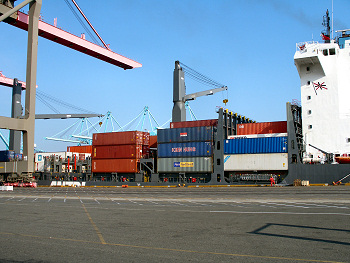
The Dirtect Kestrel
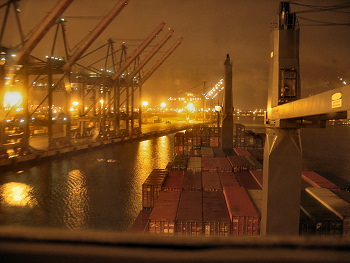
Departing L.A. at 5:00 A.M.
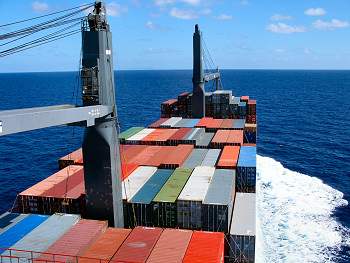
Steaming west across the Pacific
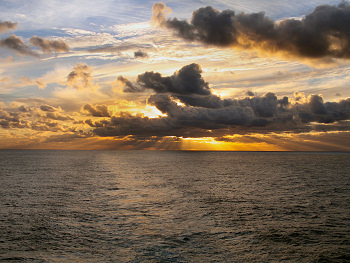
Sunset near the first sighting of Australia
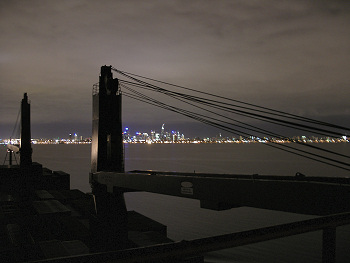
Arriving in Melbourne at 5:00 A.M.
Previous | Next
Main Index | Pre-Tour Index
Post-Tour Index | Articles Index
Slideshows
Pre-Tour
|